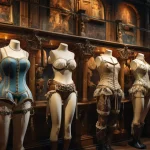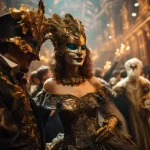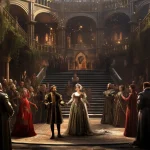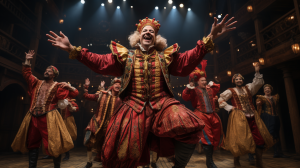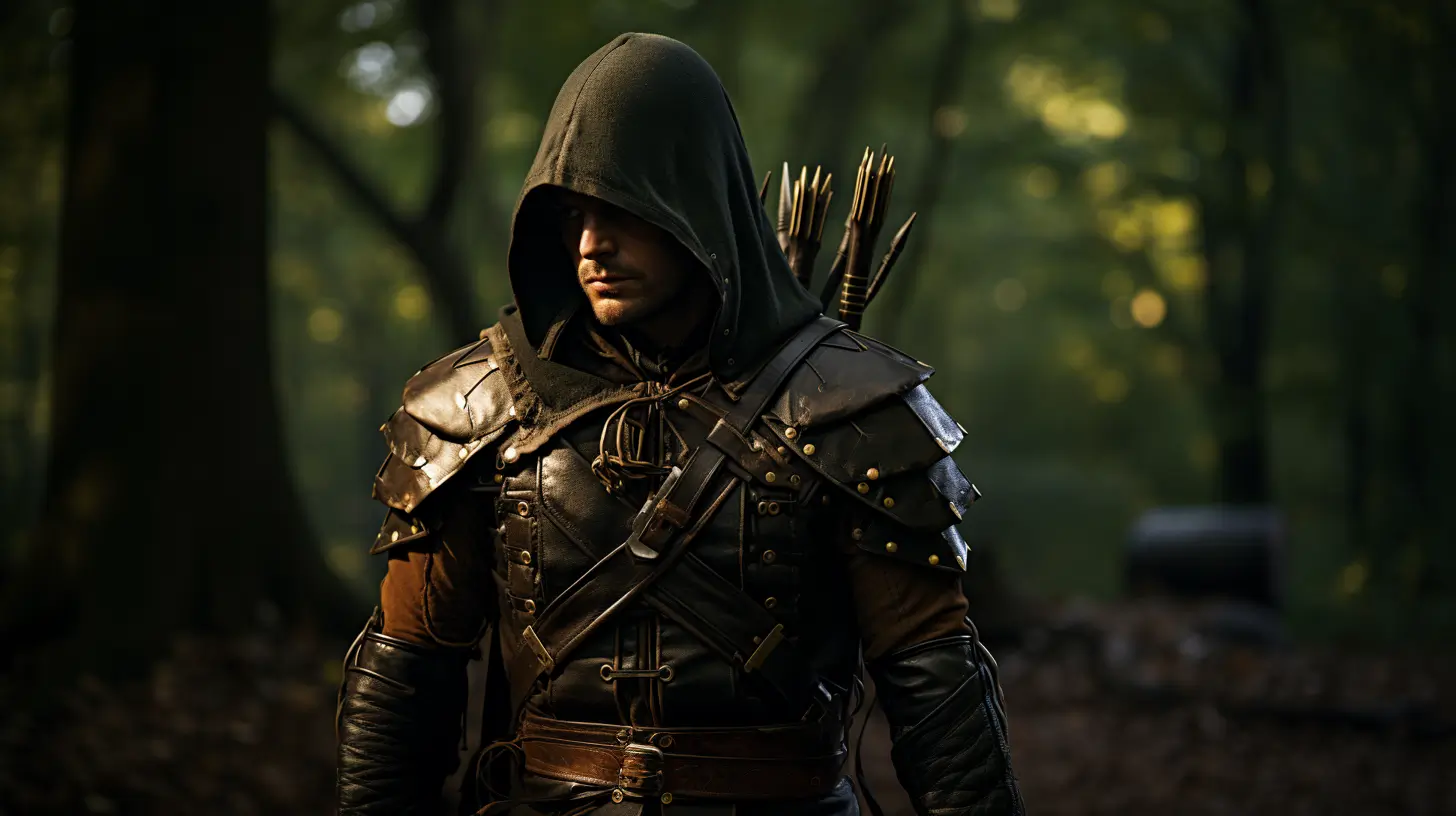
Echoes of Sherwood: The Timeless Fashion of Robin Hood
Sherwood Forest, with its tangle of branches and whispers of rebellion, is more than just the backdrop for a children’s tale. It’s the rugged cradle of a legend – Robin Hood. This guy wasn’t just a skilled archer and a thorn in the side of the rich; he was a trendsetter in his own right.
Robin Hood’s fashion – it’s not just about looking good while swiping from the rich to give to the poor. There’s a method to the medieval madness of his style. From the practical boots that tread the forest floor to the feather in his cap, each piece of his ensemble tells a story of the times, of rebellion, and of a kind of freedom that’s hard to pin down.
This isn’t just a dive into some old clothes; it’s a journey through time, tracing how a rogue’s outfit became an icon in both history books and on modern runways. So, let’s roll up our sleeves and dig into what makes Robin Hood’s fashion tick and why it’s still turning heads centuries later.
Robin Hood: The Man, The Myth, The Fashion Icon
Now, let’s dive into the heart of our story: Robin Hood. This isn’t just about a man who was good with a bow and had a problem with authority. It’s about how his style became as legendary as his exploits.
The Outlaw’s Attire Robin Hood’s fashion was a mix of practicality and statement. He didn’t dress to impress the nobles; he dressed for life in the forest and for his role as an outlaw. His attire usually consisted of a simple linen shirt, a durable tunic, and those essential breeches. But there was more to it than just function.
The Iconic Hood and Cap The most iconic part of Robin Hood’s wardrobe has to be the hood or the cap, often depicted with a feather. This wasn’t just a fashion choice; it was a symbol of his identity. In a time when your clothing said everything about who you were, that hood and cap set him apart as someone living on the edge of society, both literally and figuratively.
Boots Made for Outlaws And let’s talk about those boots. In a world where footwear was a luxury for many, Robin Hood’s boots were a necessity. They had to be sturdy enough to handle the rough terrain of Sherwood Forest and comfortable enough for those long days and nights of outwitting the sheriff.
The Bow: More Than Just a Weapon Robin Hood’s bow wasn’t just a tool for survival and rebellion; it became part of his iconic look. It symbolized his skill, his defiance, and his role as the people’s hero. In every depiction of Robin Hood, the bow is as much a part of his fashion as it is his arsenal.
A Style That Speaks Volumes Robin Hood’s style was understated but distinctive. It wasn’t just about what he wore, but how he wore it. His attire reflected his defiance against the status quo, his commitment to his cause, and his connection to the common people. He was, in many ways, the first fashion rebel.
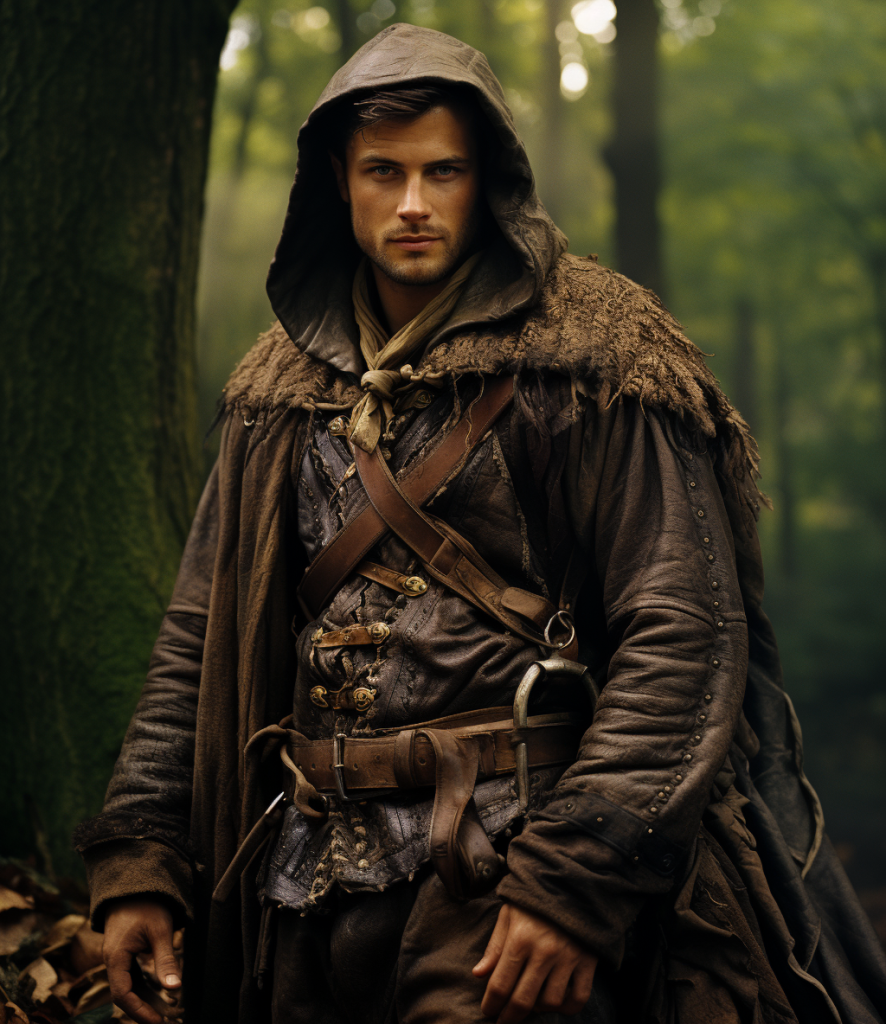
Key Elements of Robin Hood’s Fashion
Delving deeper into the details, let’s explore the key elements of Robin Hood’s attire and what they represent. Each piece of his ensemble wasn’t just a random choice; it was a part of the legend.
The Tunic: More Than Just a Garment The tunic, often depicted in Lincoln green, was a staple of Robin Hood’s wardrobe. It was practical for the life of an outlaw – loose enough for ease of movement, yet fitting enough to not get snagged in the underbrush. The choice of green wasn’t just for camouflage in the forest; it was a statement, a nod to his connection with the common people and the land.
Boots Built for the Forest His boots, rugged and durable, were designed for the rough terrain of Sherwood. They were the kind of boots that told stories of long chases, daring escapes, and silent walks through the woods. In every story, these boots weren’t just footwear; they were a testament to his lifestyle.
The Hat and the Feather: Symbols of Defiance The hat, especially the one with a feather, became synonymous with Robin Hood. It was more than just a fashion choice; it was a symbol of his playful yet defiant nature. The feather, often a pheasant or peacock feather, added a touch of flair, showcasing his flamboyant and rebellious spirit.
The Bow and Arrows: Tools and Accessories While primarily tools for survival and defense, Robin Hood’s bow and arrows also became part of his iconic look. They signified his skill and his role as a protector. In every depiction, these weren’t just weapons; they were extensions of his character.
The Belt: A Practical Accessory A sturdy belt was essential for any medieval outlaw, and Robin Hood’s was no exception. It was functional, holding his tunic in place and often used to carry his quiver or a small pouch. This belt was a utility item, but like everything else he wore, it became part of his legendary image.
Each element of Robin Hood’s attire was a blend of practicality and symbolism, creating an image that has endured through centuries. His fashion was a mirror of his life, an outlaw’s life, lived in defiance of the norm.
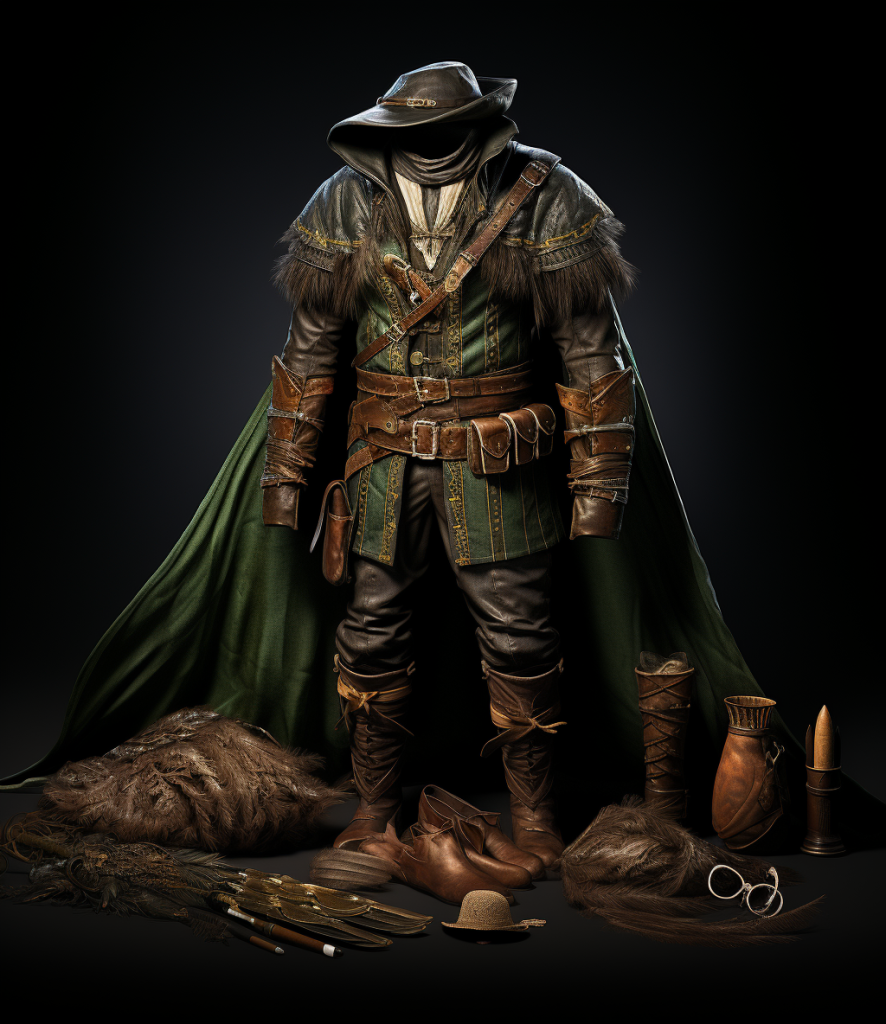
Robin Hood’s Influence on Modern Fashion
Now, let’s bridge the gap between the past and the present. Robin Hood’s style, steeped in legend and history, has left an indelible mark on modern fashion. It’s fascinating to see how elements of his iconic look have been reinterpreted and woven into contemporary styles.
From Forest to Runway: The Green Tunic The green tunic, once a symbol of an outlaw in Sherwood Forest, has found its way onto modern runways. Designers have played with its form, transforming it into everything from chic dresses to avant-garde menswear. The essence of Robin Hood’s tunic – practicality blended with a touch of rebellion – resonates in these contemporary designs.
Boots with a Tale to Tell The rugged boots of Robin Hood have evolved into a fashion staple. Today, you’ll find echoes of his practical, durable footwear in the array of boots that grace fashion stores – from the utilitarian combat boot to the stylish Chelsea boot. They carry with them a hint of the outlaw’s spirit, a nod to a life of adventure and defiance.
The Feathered Cap Reimagined While the feathered cap might not be everyone’s daily wear, its influence is unmistakable in modern fashion accessories. Designers have taken this iconic piece and spun it into modern hats, headpieces, and even hair accessories, often using feathers to add a touch of flamboyance and freedom.
Archery Chic: The Bow and Arrow While the bow and arrow might not be practical accessories in today’s world, their symbolism has been embraced in fashion. Jewelry designers, for instance, have created pieces inspired by archery, from arrow-shaped pendants to bow motifs in various accessories, capturing the elegance and precision of Robin Hood’s favored weapon.
Belts: Functional to Fashionable The belt, a practical necessity for Robin Hood, has become a fashion statement in its own right. From broad, statement belts to subtle, leather designs, the evolution of the belt in fashion reflects a blend of functionality and style, much like the belt of the legendary outlaw.
Robin Hood’s fashion legacy is a testament to how style can transcend time and context, influencing generations far beyond its origin. It’s a reminder that sometimes, the clothes do indeed make the man… or the legend.
Fashion as a Symbol of Rebellion and Freedom
Robin Hood’s fashion wasn’t just about what he wore; it was about what he stood for. It’s time to explore how his style reflects themes of rebellion and freedom, and how this has echoed through the ages, influencing not just fashion, but cultural and social movements.
Rebellion Woven into Fabric Robin Hood’s choice of simple, practical clothing was in direct contrast to the opulent attire of the nobility. This wasn’t a mere fashion choice; it was a statement. His attire symbolized a rejection of the extravagant lifestyle of the wealthy and a solidarity with the common folk. It was his way of silently rebelling against the status quo.
The Outlaw Aesthetic The ‘outlaw’ look, popularized by Robin Hood, has become a recurring theme in fashion. This style often includes elements like rugged boots, utilitarian belts, and earthy tones, embodying a spirit of defiance and nonconformity. It’s about dressing in a way that challenges traditional norms and expresses a sense of independence.
Fashion as a Form of Expression and Resistance Throughout history, fashion has been used as a tool for expression and resistance, much like Robin Hood used his attire. From the suffragettes’ use of white to symbolize purity and strength in their fight for voting rights, to the black berets of the Black Panthers as a symbol of empowerment and resistance, clothing has been a powerful medium for conveying messages and uniting causes.
The Enduring Appeal of the Rebel The appeal of the fashion rebel – someone who dresses outside the norms, who uses clothing to make a statement – remains strong. This figure, embodied by Robin Hood, resonates with those who see fashion as a way to break barriers and express their individuality. It’s a reminder that sometimes, the most powerful fashion statements are those that defy convention.
Robin Hood’s legacy in fashion is more than just about the clothes he wore; it’s about the ideals he represented. His style was a reflection of his character, a symbol of rebellion, and a beacon of freedom. This influence continues to inspire and resonate in modern fashion and culture.
The Artistic and Cultural Legacy of Robin Hood’s Fashion
Robin Hood’s fashion has transcended mere clothing to become a significant part of his artistic and cultural legacy. This final section explores how his iconic style has influenced art, literature, and film, and why it continues to capture our imagination.
Robin Hood in Art and Literature Robin Hood’s attire has been a source of inspiration in art and literature for centuries. From the earliest ballads to modern novels, his distinctive look has been a key element in portraying his character. Artists and writers have often used his clothing to symbolize his connection to the common people and his role as a hero.
Cinematic Interpretations: A Visual Feast In film, Robin Hood’s fashion has been reimagined in numerous ways, reflecting different interpretations of the legend. From Errol Flynn’s dashing depiction in bright Lincoln green to more recent, grittier portrayals, his attire remains central to his character. Each adaptation offers a new take on his iconic style, blending historical accuracy with artistic license.
Fashion’s Role in Shaping Robin Hood’s Image The evolution of Robin Hood’s image over time highlights the powerful role fashion plays in character development. His clothing choices have helped cement his image as the heroic outlaw, shaping how audiences perceive and relate to him.
The Timeless Appeal of Robin Hood’s Style The reason Robin Hood’s style endures is its blend of practicality, symbolism, and a touch of romanticism. It resonates with our love for the underdog and the rebel, and it appeals to our sense of adventure. It’s a style that feels both historical and surprisingly modern, bridging the gap between past and present.
Robin Hood’s fashion is more than just a historical curiosity; it’s a key part of his legend and a reflection of the era he represents. His style continues to inspire and influence, proving that some aspects of fashion are indeed timeless.
As we draw the curtains on our journey through the fashion and legacy of Robin Hood, it’s clear that his style is much more than just a historical footnote. It’s a rich tapestry that weaves together themes of rebellion, identity, and timeless appeal.
More Than Just Clothes Robin Hood’s attire, from his Lincoln green tunic to his feathered cap, was never just about the clothes. It was a symbol of his defiance against the establishment, his solidarity with the common folk, and his role as an iconic hero. His fashion choices tell a story of a man who stood firmly for his beliefs, dressed not for vanity but for purpose.
A Lasting Influence The enduring appeal of Robin Hood’s fashion is evident in how it continues to inspire modern design, art, and storytelling. His iconic style transcends time and culture, reminding us of the power of clothing to convey deeper meanings and values.
The Universal Rebel Robin Hood remains a symbol of the timeless rebel, a character whose fashion sense, as much as his legendary exploits, has cemented his place in history. His legacy in fashion is a testament to the idea that sometimes, what we wear speaks volumes about who we are and what we stand for.
A Story Woven in Fabric In closing, Robin Hood’s fashion is more than just an element of his legend. It’s a narrative woven in fabric and thread, a reflection of a bygone era that continues to resonate in our collective consciousness. It’s a reminder that fashion can be a powerful form of expression, a way to connect with our past, and a lens through which we can view our present and future.
Robin Hood’s fashion, much like his legend, is a tale that continues to inspire and captivate. It’s a story that speaks of freedom, rebellion, and the enduring power of style.



